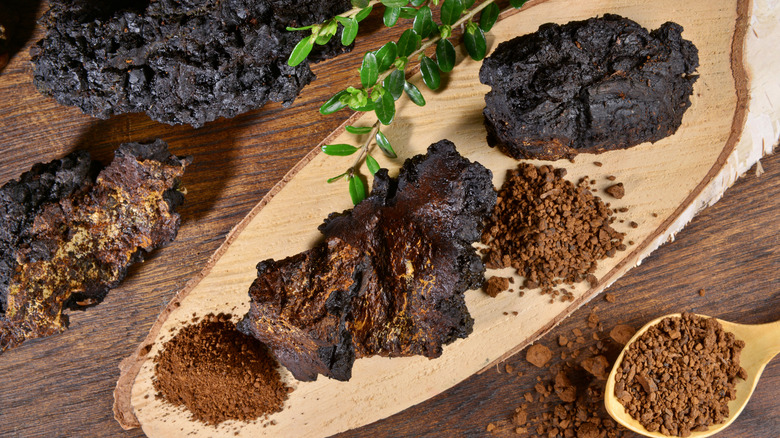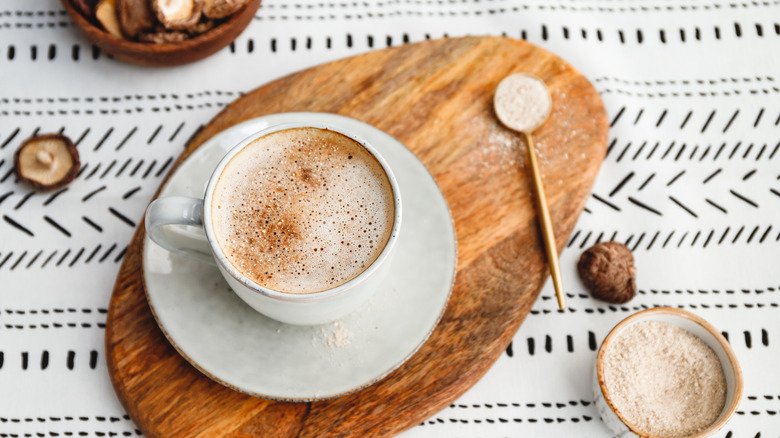When To Use Mushroom Powder As Your 'Secret Ingredient'
While some people might make punny jokes about a functional food, mushroom powder can be the umami boost that transforms a bland dish. Sure, mushrooms have served as a meat substitute, a side dish to a steak, and other offerings, but the dried, powder form deserves to be front and center on the spice shelf. In fact, some people might not want to share this secret ingredient because it can be an easy way to enhance almost any recipe. From eating more veggies to rounding out the flavor in a nuanced recipe, it might be time to sprinkle this super food on almost anything.
When the five flavor elements are in harmony, a recipe hits a high note of enjoyment. Umami, the fifth flavor element, is often associated with mushrooms. As Om Mushroom Superfood explains, that note hits particular flavor receptors on the tongue. Mushrooms, which are often associated with umami, impart an earthy, yet subtle quality. Although salt is always part of seasoning a dish, using mushroom powder can enhance the other ingredients without offsetting the balance or adding unwanted extras. Although it might not join the salt and pepper on the table, it might become a kitchen staple for the aspiring cook.
Choosing the right mushroom powder for certain recipes
While mushroom powder offers an umami punch, there are many variations on the concept. Since it is basically dried mushrooms pulsed into a fine powder, almost like a salt or spice, the type of mushroom used will change the flavor. As discussed in the Seattle Times, dried shiitake mushrooms versus porcini mushrooms are more than just a regional preference. Specifically, the article describes the difference in flavor from shiitake's intense umami to porcini's aromatic elegance. Although some cooks will stick to one fungi over another, others might prefer to see how the various dried mushrooms can better enhance certain recipes. From a dry rub for a steak to a component in a curry, the options are many.
Although some people make their own mushroom powder, there are some store-bought options available on the shelf. When choosing a brand, consider the type of mushroom used as well as other added ingredients. For example, if the idea is to use mushroom powder as a salt replacement, a pre-made version with salt might not be the best idea. In addition, some commercial varieties use the mushroom stem instead of the cap, which might not have the same flavor or nutritional benefits that the other mushroom parts can offer. If controlling the ingredients in a recipe is vital, it might be better to grab the coffee grinder, throw in some dried mushrooms, and get pulsing.
Can mushroom powder be used in savory and sweet recipes?
While many cooks use mushroom powder to enhance the flavor of a recipe, others use the ingredient for its functional benefits. Real Mushrooms discusses how the potential medicinal benefits of incorporating this ingredient into recipes are balanced by the various flavors each type offers. For example, mushroom coffee and tea soared in popularity in 2018. The alternative to the traditional caffeine boost, these recipes blended cacao with various mushroom powders to create a frothy delight. Additionally, the mushroom powder can be incorporated into other sweet recipes like smoothies, brownies, and even ice cream.
Although the sweet recipes might satisfy a particular craving, the savory applications are often more obvious. From a simple sprinkling to seasoning eggs to rub for protein, there are plenty of dashes to go around. In some ways, this ingredient could be considered a superfood because of its versatility, not just its potential nutritional benefits. In the end, there are many ideas sprouting in the kitchen for mushroom powder. It might not be in that spice rack right now, but it certainly deserves a spot in the ingredient rotation.


